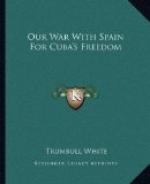There is no more charming spot in Cuba than Matanzas. The bay is like a crescent in shape, and receives the waters of the Yumuri and Matanzas rivers, two small unnavigable streams. A high bridge separates them. On this ridge back of the town stands a cathedral dedicated to the black virgin. It is a reproduction of a cathedral in the Balearic Islands. The view from its steeple is magnificent. Looking backward the valley of the Yumuri stretches to the right. It is about ten miles wide and sixty miles long, dotted with palms, and as level as a barn floor. The Yumuri breaks through the mountains near Matanzas bay something like the Arkansas river at Canon City. Carpeted with living green and surrounded with mountains this valley is one of the gems of Cuba.
About ten miles from Matanzas, on the left of the road, stand what are known as the Breadloaf Mountains. They rise from the plain like the Spanish peaks in Colorado. These mountains are the headquarters of General Betancourt, who commands the insurgents in the province. The Spaniards have offered $1,000 reward for his head. Several efforts have been made to secure it, but in all cases the would-be captor has lost his own head.
In accordance with the Weyler edict 11,000 reconcentrados were herded together at Matanzas, and within a year over 9,000 of them died in the city. In the Plaza, under the shadow of the Governor’s residence, twenty-three people died from starvation in one day. The province of Matanzas is not larger in area than the state of Delaware, yet 55,000 people have perished from starvation and incident diseases since the order went into effect.
But all the people of Matanzas are not reconcentrados, and even in the midst of war’s alarms they find time for amusement, as the following description of a carnival ball will prove:
“It was our good fortune to be in Matanzas during the last three days of the Carnival; and while the whole time was occupied by noisy processions and grotesque street masqueraders, the crowning ceremonies were on the last Sunday night. Then the whole town used every effort to wind up the season in a ‘feu de joie’ of pleasure and amusement. In almost every town of any importance there is an association of young men, generally known as ‘El Liceo,’ organized for artistic and literary purposes, and for social recreation. A fine large building is generally occupied by the association, with ample space for theatrical representations, balls, etc.; in addition to which there are billiard rooms, and reading rooms, adorned, probably with fine paintings. In Matanzas this association is known as ’El Liceo Artistico y Literario de Matanzas,’ and is a particularly fine one, being composed of the elite of the city, with a fine large house, to which they made an addition by purchasing the ‘Club,’ beautifully situated upon the Plaza.
“Thanks to our letter of introduction, we were, through the kind offices of the members, permitted to enjoy the pleasures of their grand ball, called the ‘Pinata,’ which was indeed a very grand affair, attended by the beauty and fashion of Matanzas. The ball commenced at the seasonable hour of 8 o’clock in the evening; and at entering, each one was required to give up his ticket to a committee of managers, who thus had a kind of general inspection of all those admitted.




